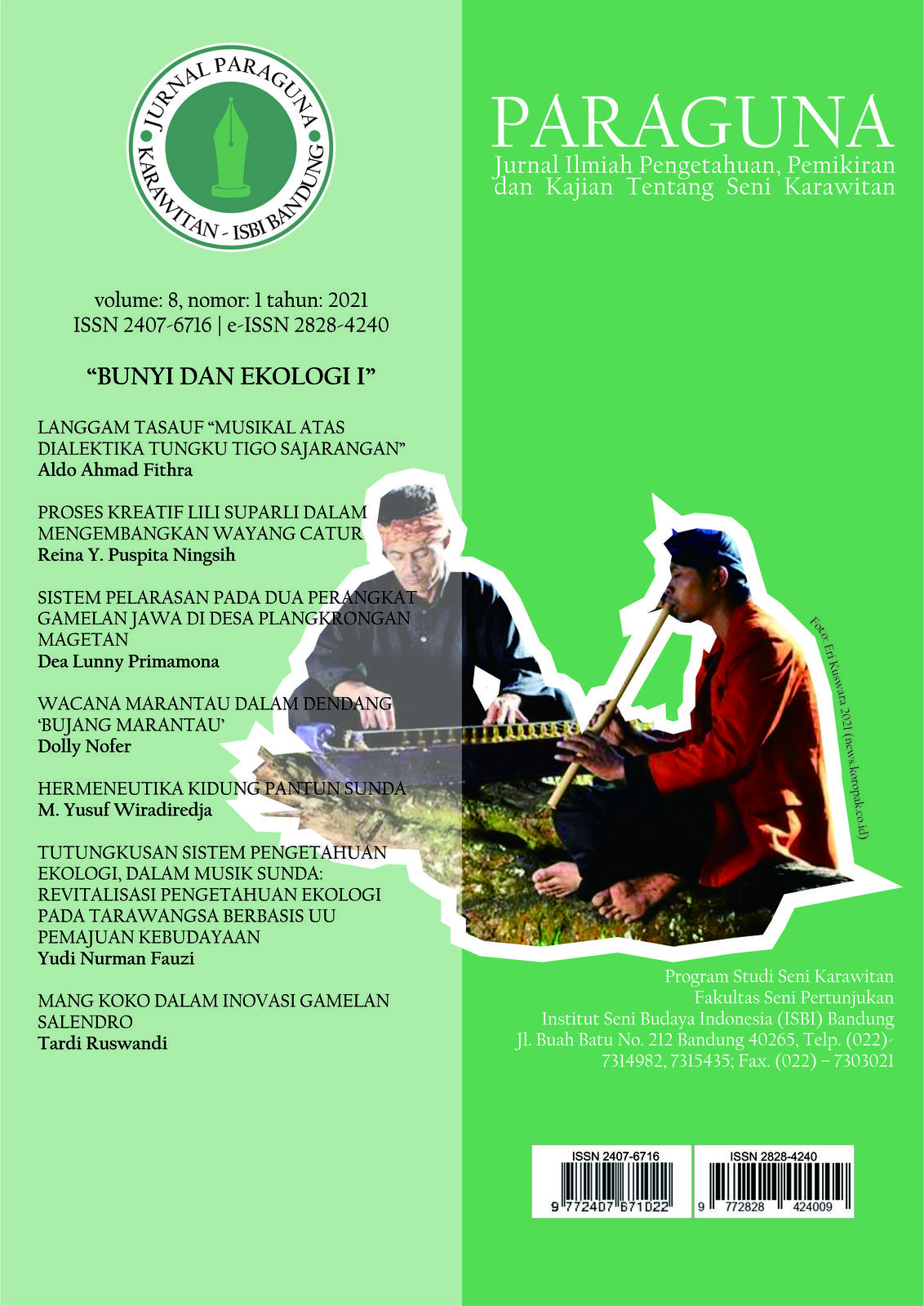SISTEM PELARASAN PADA DUA PERANGKAT GAMELAN JAWA DI DESA PLANGKRONGAN MAGETAN
DOI:
https://doi.org/10.26742/jp.v8i1.1893Keywords:
tuning system, range, embat, Javanese gamelan, Plangkrongan VillageAbstract
Javanese gamelan music is an integral part of society's lives in Plangkrongan Village, Poncol, Magetan, but musical data records on tuning have never existed. Musical data records can be used as an archipelagic strategy for today's millennial generation to introduce the sound heritage of the archipelago's civilization to the next generation. Therefore, this study aims to determine: 1) knowing the tuning system, and 2) the embat used on several gamelan devices in the village.
This study uses an ethnomusicological approach. The methods used include: 1) interviews and measurements; 2) comparative analysis and inductive inference; and 3) narrative descriptions with pictures and tables. This study collects musical data such as the tone, range, and embat systems of the gamelan Nugroho Mulyo and Gong Mbarang belonging to two well-known artists in Plangkrongan Village. Based on the data, it can be concluded that: 1) Gamelan is tuned in one gembyang from low nem to high nem; 2) Gamelan is tuned in the middle register so that it is easy to voice and listen; 3) The pelog barrel has the longest range of 486 cents, while the shortest range is 99 cents. While the slendro barrel has the longest range of approximately 310 cents, the average range is between 243 to 260 cents and the shortest range is 206 cents; and 4) The term structure states that the embat used is Sundari embat so as to produce a complete musical sense. This musical data record can be an important archive for ethnomusicologists, musicians and musicians, and observers of musical art in the archipelago in general and in Magetan in particular.
References
Haryono, Timbul. 2004. Seni Pertunjukan Pada Masa Jawa Kuno. Yogyakarta: Pustaka Raja.
———. 2009. Seni dalam Dimensi Bentuk, Ruang, dan Waktu. Jakarta: Wedatama Widya Sastra.
Hastanto, Sri. 2012a. Kajian Musik Nusantara-II. Surakarta: ISI Press.
———. 2012b. Ngeng & Reng, Persandingan Sistem Pelarasan Gamelan Ageng Jawa dan Gong Kebyar. Surakarta: ISI Press.
Holt, Claire. 2000. Melacak Jejak Perkembangan Seni di Indonesia. Bandung: arti.line.
Lombard, Denys. 1996. Nusa Jawa: Silang Budaya Kajian Sejarah Terpadu. Gramedia Pustaka Utama.
Primamona, Dea Lunny, dan Dolly Nofer. 2019. “Ledhug: Syncretic Music Culture in Magetan.” Dewa Ruci: Jurnal Pengkajian dan Penciptaan Seni 14 (2): 1–12.
Rustopo. 2012. Sejarah Kebudayaan Indonesia I. Surakarta: ISI Press.
Sedyawati, Edi. 2006. Budaya Indonesia: Kajian arkeologi, seni, dan sejarah. Divisi Buku Perguruan Tinggi, Raja Grafindo Persada.
Sumarsam. 2018. Memaknai Wayang dan Gamelan Temu Silang Jawa, Islam, dan Global. Yogyakarta: Gading.
Downloads
Published
Issue
Section
Citation Check
License
- Authors retain copyright and grant the journal right of first publication with the work simultaneously licensed under a Creative Commons Attribution License that allows others to share the work with an acknowledgement of the work's authorship and initial publication in this journal. Authors are able to enter into separate, additional contractual arrangements for the non-exclusive distribution of the journal's published version of the work (e.g., post it to an institutional repository or publish it in a book), with an acknowledgement of its initial publication in this journal. Authors are permitted and encouraged to post their work online (e.g., in institutional repositories or on their website) prior to and during the submission process, as it can lead to productive exchanges, as well as earlier and greater citation of published work.









